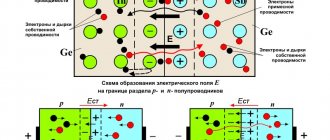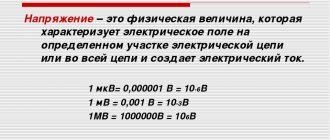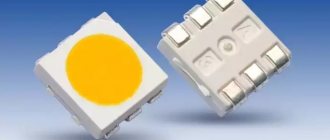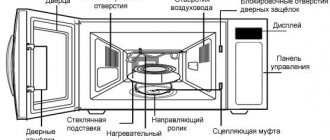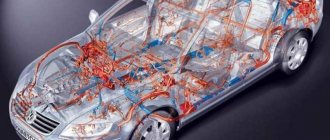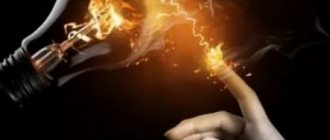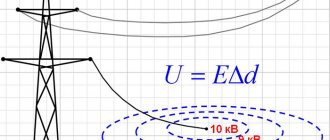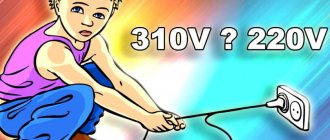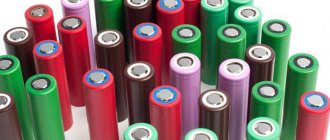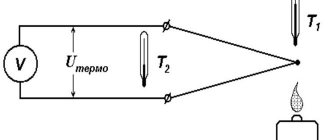What it is
VAC stands for current-voltage characteristic of a diode semiconductor. It reflects the dependence of the current that passes through the pn junction of the diode. The current-voltage characteristic determines the dependence of the current on the magnitude, as well as the polarity of the applied voltage. The current-voltage characteristic has the form of a graph (diagram). This graph looks like this:
I-V characteristic for a diode
For each type of diode, the current-voltage characteristic graph will have its own specific appearance. As you can see, the graph contains a curve. The values of forward current (direct connection) are marked vertically at the top, and in reverse at the bottom. But the horizontal diagram and graph display the voltage, similarly in the forward and reverse directions. Thus, the current-voltage characteristic diagram will consist of two parts:
- upper and right part - the element operates in the forward direction. It reflects the passing current. The line in this part goes sharply upward. It characterizes a significant increase in forward voltage;
- lower left part - the element acts in the opposite direction. It corresponds to the closed (reverse) current through the junction. Here the line runs almost parallel to the horizontal axis. It reflects the slow increase in reverse current.
Note! The steeper the vertical top part of the graph is, and the closer the bottom line is to the horizontal axis, the better the rectifying properties of the semiconductor will be.
It is worth noting that the current-voltage characteristic strongly depends on the ambient temperature. For example, an increase in air temperature can lead to a sharp increase in the reverse current. You can build a current-voltage curve with your own hands as follows:
- take the power supply;
- connect it to any diode (minus to the cathode, plus to the anode);
- We take measurements using a multimeter.
From the data obtained, the current-voltage characteristic for a specific element is constructed. Its diagram or graph may look like this.
Nonlinear current-voltage characteristic
The graph shows the current-voltage characteristic, which in this design is called nonlinear. Let's look at examples of different types of semiconductors. For each individual case, this characteristic will have its own schedule, although they will all be of the same nature with only minor changes.
Device
Below is a detailed description of the diode structure; studying this information is necessary for further understanding of the principles of operation of these elements:
- The housing
is a vacuum cylinder that can be made of glass, metal or durable ceramic varieties of material. - inside the cylinder
. The first is a heated cathode, which is designed to ensure the process of electron emission. The simplest cathode in design is a filament with a small diameter, which heats up during operation, but today indirectly heated electrodes are more common. They are cylinders made of metal and have a special active layer capable of emitting electrons. - Inside the indirectly heated
there is a specific element - a wire that glows under the influence of electric current, it is called a heater. - The second electrode
is the anode, it is needed to receive the electrons that were released by the cathode. To do this, it must have a potential that is positive relative to the second electrode. In most cases, the anode is also cylindrical. - Both electrodes
of vacuum devices are completely identical to the emitter and base of the semiconductor variety of elements.
Silicon or germanium is most often used to make a diode crystal One of its parts is p-type electrically conductive and has a deficiency of electrons, which is formed by an artificial method. The opposite side of the crystal also has conductivity, but it is n-type and has an excess of electrons. There is a boundary between the two regions, which is called a pn junction.
Such features of the internal structure give diodes their main property - the ability to conduct electric current in only one direction.
CVC for shotky
One of the most common diodes today is Schottky. This semiconductor was named after the German physicist Walter Schottky. For Schottky, the current-voltage characteristic will have the following form.
CVC for Schottky
As you can see, Schottky is characterized by a low voltage drop in a direct connection situation. The graph itself is clearly asymmetrical. In the forward displacement zone, an exponential increase in current and voltage is observed. Under reverse and forward bias for a given element, the current in the barrier is due to electrons. As a result, such elements are characterized by rapid action, since there are no diffuse and recombination processes. In this case, the asymmetry of the current-voltage characteristic will be typical for barrier-type structures. Here, the dependence of current on voltage is determined by a change in the number of carriers that take part in charge transfer processes.
Application areas of diodes
Despite their simple design, semiconductor diodes are widely used in electronics:
- For rectification of alternating voltage. A classic of the genre - the property of a pn junction to conduct current in one direction is used.
- Diode detectors. Here, the nonlinearity of the current-voltage characteristic is used, which makes it possible to isolate harmonics from the signal, the necessary ones of which can be isolated by filters.
- Two diodes connected back-to-back serve as a limiter for powerful signals that can overload subsequent input stages of sensitive radio receiving devices.
- Zener diodes can be switched on as spark-protective elements that prevent high-voltage pulses from entering the circuits of sensors installed in hazardous areas.
- Diodes can serve as switching devices in high-frequency circuits. They open with a constant voltage and allow (or do not allow) the RF signal to pass through.
- Parametric diodes serve as amplifiers of weak signals in the microwave range due to the presence in the forward branch of the characteristic of a section with negative resistance.
- Mixers operating in transmitting or receiving equipment are assembled using diodes. They mix the local oscillator signal with a high-frequency (or low-frequency) signal for subsequent processing. The nonlinearity of the current-voltage characteristic is also used here.
- The nonlinear characteristic allows the use of microwave diodes as frequency multipliers. When a signal passes through a multiplying diode, higher harmonics are released. They can then be identified by filtering.
- Diodes are used as tuning elements in resonant circuits. In this case, the presence of controlled capacitance at the pn junction is used.
- Some types of diodes are used as generators in the microwave range. These are mainly tunnel diodes and devices with the Gunn effect.
This is only a brief description of the capabilities of dual-lead semiconductor devices. With an in-depth study of the properties and characteristics, many problems posed to developers of electronic equipment can be solved using diodes.
Watch this video on YouTube
Operating principle and main characteristics of a zener diode
What is a diode bridge, its operating principle and connection diagram
Description, technical characteristics and analogues of rectifier diodes of the 1N4001-1N4007 series
What is a thyristor, how does it work, types of thyristors and a description of the main characteristics
What is an LED, its operating principle, types and main characteristics
What is a varistor, main technical parameters, what is it used for
Silicon diode and its current-voltage characteristic
In addition to Schottky, silicon semiconductors are very popular at the moment. For a silicon type diode, the current-voltage characteristic looks like this.
I-V characteristics of silicon and germanium diode
For such semiconductors, this characteristic begins at approximately 0.5-0.7 Volts. Very often, silicon semiconductors are compared with germanium semiconductors. If the ambient temperatures are equal, then both devices will exhibit bandgap. In this case, a silicon element will have a lower forward current than one made from germanium. The same rule applies to reverse current. Therefore, germanium semiconductors usually immediately experience thermal breakdown if there is a high reverse voltage. As a result, in the presence of the same temperature and forward voltage, the potential barrier for silicon semiconductors will be higher and the injection current lower.
PN junction
Let us consider the processes occurring when current passes through an electron-hole junction
. The left layer, designated n, has electronic conductivity. The current in it is associated with the movement of free electrons, which are conventionally indicated by circles with a minus sign. The right layer, designated p, has hole conductivity. The current in this layer is associated with the movement of holes, which are indicated in the figure by circles with a “plus”.
Movement of electrons and holes in direct conduction mode
When semiconductors with different types of conductivity come into contact, electrons due to diffusion
will begin to move to the p-region, and holes - to the n-region, as a result of which the boundary layer of the n-region becomes positively charged, and the boundary layer of the p-region - negatively. An electric field arises between the regions, which acts as a barrier for the main current carriers, due to which a region with a reduced charge concentration is formed in the pn junction. The electric field in a pn junction is called a potential barrier, and the pn junction is called a blocking layer. If the direction of the external electric field is opposite to the direction of the field of the pn junction (“+” in the p-region, “-” in the n-region), then the potential barrier decreases, the concentration of charges in the pn junction increases, the width and, therefore, the resistance of the junction decreases. When the source polarity changes, the external electric field coincides with the direction of the pn junction field, the width and resistance of the junction increases. Therefore, the pn junction has gate properties.
I-V characteristics and rectifier diode
In conclusion, I would like to consider this characteristic for a rectifier diode. A rectifier diode is one of the types of semiconductor that is used to convert alternating current to direct current.
I-V characteristic for a rectifier diode
The diagram shows the experimental current-voltage characteristic and the theoretical one (dashed line). As you can see, they do not match. The reason for this lies in the fact that some factors were not taken into account for theoretical calculations:
- the presence of ohmic resistance in the base and emitter regions of the crystal;
- his findings and contacts;
- the possibility of leakage currents along the crystal surface;
- the occurrence of recombination and generation processes in the transition for carriers;
- various types of breakdowns, etc.
All these factors can have different effects, leading to a real current-voltage characteristic that differs from the theoretical one. Moreover, the ambient temperature has a significant impact on the appearance of the graph in this situation. The current-voltage characteristic for a rectifier diode demonstrates the high conductivity of the device when a voltage is applied to it in the forward direction. In the opposite direction, low conductivity is observed. In such a situation, current practically does not flow through the element in the opposite direction. But this only happens at certain reverse voltage parameters. If it is exceeded, then the graph shows an avalanche-like increase in the current in the opposite direction.
Purpose
Below are the main areas of application of diodes, from which their main purpose becomes clear:
- Diode bridges
are 4, 6 or 12 diodes connected to each other, their number depends on the type of circuit, which can be single-phase, three-phase half-bridge or three-phase full-bridge. They perform the functions of rectifiers; this option is most often used in automobile generators, since the introduction of such bridges, as well as the use of brush-collector units with them, has made it possible to significantly reduce the size of this device and increase its reliability. If the connection is made in series and in one direction, this increases the minimum voltage required to unlock the entire diode bridge. - Diode detectors
are obtained by combining these devices with capacitors. This is necessary so that it is possible to isolate low-frequency modulation from various modulated signals, including the amplitude-modulated variety of the radio signal. Such detectors are part of the design of many household appliances, such as televisions or radios. - Ensuring protection of consumers from incorrect polarity when switching on circuit inputs from occurring overloads or switches from breakdown by electromotive force that occurs during self-induction, which occurs when the inductive load is turned off. To ensure the safety of circuits from overloads that occur, a chain is used consisting of several diodes connected to the supply buses in the reverse direction. In this case, the input to which protection is provided must be connected to the middle of this chain. During normal operation of the circuit, all diodes are in a closed state, but if they have detected that the input potential has gone beyond the permissible voltage limits, one of the protective elements is activated. Due to this, this permissible potential is limited within the permissible supply voltage in combination with a direct drop in the voltage on the protective device.
- Switches
based on diodes are used to switch high-frequency signals. Such a system is controlled using direct electric current, high-frequency separation and the supply of a control signal, which occurs due to inductance and capacitors. - Creation of diode spark protection
. Shunt-diode barriers are used, which provide safety by limiting the voltage in the corresponding electrical circuit. In combination with them, current-limiting resistors are used, which are necessary to limit the electric current passing through the network and increase the degree of protection.
The use of diodes in electronics today is very widespread, since virtually no modern type of electronic equipment can do without these elements.
What does a diode consist of?
In our world there are substances that perfectly conduct electric current. This mainly includes metals, for example, silver, copper, aluminum, gold and so on. Such substances are called conductors. There are substances that conduct electricity very poorly - porcelain, plastics, glass, and so on. They are called dielectrics or insulators. Between conductors and dielectrics are semiconductors. These are mainly germanium and silicon.
Once germanium or silicon is mixed with a minute fraction of arsenic or indium, an N-type semiconductor is formed when mixed with arsenic; or a P-type semiconductor when mixed with indium.
Now if these two P and N type semiconductors are welded together, a PN junction is formed at their junction. This is the structure of a diode. That is, the diode consists of a PN junction.
The P-type semiconductor in the diode is the anode, and the N-type semiconductor is the cathode.
Let's open the Soviet D226 diode and see what's inside it by grinding off part of the body on an emery wheel.
diode D226
This is the same PN junction
PN junction diode
How to determine voltage and polarity
An LED only allows current to pass in one direction.
Therefore, it is important to connect the device to the circuit correctly. To do this, you need to determine which of the body terminals is the cathode and which is the anode.
- Visually, traditionally the cathode leg is short and the anode leg is long. The cathode has a minus sign, the anode has a plus sign. You can find the cathode in another way. Looking carefully through the case, you can see the crystal on the stand. The output of the stand will be the cathode.
- Connecting to a power source - select a device whose voltage is not higher than the permissible voltage for the LED. Usually this is a battery or resistor. When positioned correctly, the LED glows brighter.
- Using a multimeter - set the scale on the device to resistance measurement mode and touch the leads to the LED terminals with the probes. The contact is very short. When connected in reverse, the multimeter does not show anything; when connected correctly, it measures the resistance in the region of 1.7 kOhm.
